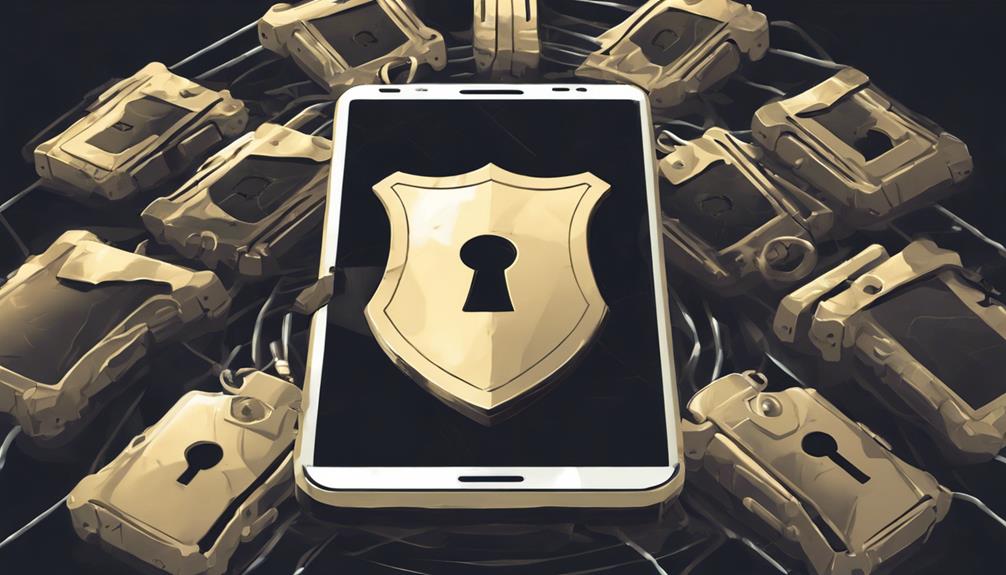Esim technology integrates advanced security measures, including secure elements and encryption, effectively shielding it from hacker intrusions. Secure provisioning methods and strong authentication protocols create formidable barriers against potential breaches. Although vulnerabilities in remote provisioning processes exist, vigilance and two-factor authentication mitigate these risks. Updates and encrypted communication guarantee eSIM data remains secure. Phishing attempts pose a threat, emphasizing the importance of user caution and protection of sensitive activation codes. Regular software updates fortify defenses, addressing security loopholes and safeguarding against unauthorized access. The thorough security measures in place contribute to the overall safety of eSIM technology from cyber threats.
Key Takeaways
- eSIM technology utilizes advanced security features like encryption and secure elements.
- Strong authentication methods and secure provisioning hinder hackers.
- Regular software updates and encrypted communication protocols bolster security.
- Phishing attempts pose risks, emphasizing the importance of user vigilance.
- Two-Factor Authentication (2FA) and biometric verification enhance eSIM security.
Esim Security Overview
The security of eSIM technology is reinforced by robust measures that greatly reduce the risk of unauthorized access by hackers. eSIMs employ advanced security features such as secure elements, encryption, strong authentication protocols, and secure provisioning methods, making it challenging for malicious actors to breach the system.
Unlike traditional SIM cards, eSIMs eliminate physical vulnerabilities, enhancing overall security by storing sensitive data in a secure manner. Remote provisioning of eSIMs further enhances security, minimizing the risk of unauthorized access to data. The use of encryption methods guarantees data integrity and confidentiality, safeguarding information from potential breaches.
Vulnerabilities in Remote Provisioning

Amid the advancements in eSIM technology, vulnerabilities in remote provisioning processes pose significant security risks that can be exploited by hackers.
These vulnerabilities, such as those stemming from the use of QR codes, can allow hackers to gain unauthorized access to devices and exploit weaknesses in eSIM authentication.
Weak authentication methods in eSIM remote provisioning make it a prime target for hackers seeking unauthorized control over phone numbers.
The repercussions of such breaches are severe, with opportunities for financial fraud, identity theft, and data breaches becoming prevalent.
The compromised security measures during remote provisioning open doors for hackers to orchestrate various malicious activities, jeopardizing both individual privacy and financial security.
As eSIM adoption increases, the need for robust security measures in remote provisioning processes becomes paramount to safeguard against the evolving tactics employed by cybercriminals.
Importance of Strong Authentication Measures

Implementing robust authentication measures is paramount for enhancing the security of eSIM technology against potential hacking threats. By incorporating two-factor authentication (2FA), users can add an extra layer of protection to their eSIM profiles, reducing the risk of unauthorized access. Biometric verification, such as fingerprint or facial recognition, further strengthens security by ensuring only authorized individuals can access the eSIM data. Regular software updates and security patches are crucial in addressing vulnerabilities and safeguarding against potential breaches. Utilizing encrypted communication protocols and establishing secure network connections help protect eSIMs from interception and tampering by malicious actors. Educating users on the dangers of phishing attempts and emphasizing the importance of creating unique, complex passwords can prevent unauthorized access to eSIM data. By implementing these strong authentication measures, eSIM technology can significantly enhance its resistance to hacking attempts.
| Authentication Measure | Description |
|---|---|
| Two-Factor Authentication (2FA) | Adds an extra layer of security by requiring two forms of identification. |
| Biometric Verification | Uses unique physical characteristics for user authentication. |
| Software Updates | Regularly updating device software to address security vulnerabilities. |
| Encrypted Communication Protocols | Secures data transmission through encryption methods. |
| Secure Network Connections | Establishes protected connections to prevent data interception. |
Risks of Phishing Attempts

Guarding against phishing attempts is paramount in protecting eSIM users from potential security breaches. Phishing attempts targeting eSIM users involve deceptive tactics aimed at extracting sensitive information, such as eSIM activation codes, from unsuspecting individuals.
Hackers often masquerade as legitimate service providers through fraudulent emails or messages to dupe users into divulging their eSIM details. Sharing eSIM activation codes, passwords, or personal information in response to unsolicited requests can lead to unauthorized access to eSIM profiles, compromising both device security and personal data.
Hence, it is essential for eSIM users to exercise vigilance and refrain from falling prey to these malicious tactics. By being cautious and avoiding sharing confidential information with unknown sources, individuals can mitigate the potential hacking risks associated with phishing attempts and safeguard the security of their eSIM profiles effectively.
Significance of Software Updates

Enhancing eSIM security through regular software updates is essential to fortify the defense mechanisms against potential cyber threats.
Software updates play a vital role in bolstering eSIM security by providing patches for known vulnerabilities and strengthening the security protocols of eSIM-enabled devices.
Keeping the device's operating system up to date is critical as it reduces the risk of hacking attempts targeting eSIM technology.
Updated software guarantees that any potential security loopholes in the eSIM system are promptly addressed, thereby safeguarding eSIM data from unauthorized access and potential hacking threats.
Monitoring for Suspicious Activity

Vigilantly monitoring your eSIM-enabled device for any signs of suspicious activity is imperative for safeguarding its security against potential threats. To effectively protect your eSIM from unauthorized access and potential hacks, consider the following measures:
- Regularly Track Network Connections and Data Usage:
Monitoring your network connections and data usage can help you detect any unusual patterns or unexpected activities that may indicate unauthorized access to your eSIM.
- Set Up Alerts for eSIM Profile Changes:
Stay proactive by setting up alerts or notifications for any changes in your eSIM profile. Being promptly informed about modifications can help you identify and address any unauthorized alterations.
- Investigate Unexpected Charges:
Be vigilant in investigating any unexpected charges or unfamiliar activities on your account. Promptly addressing these issues can prevent further potential security breaches.
Frequently Asked Questions
What Is Safer SIM or Esim?
When comparing the safety of traditional SIM cards and eSIM technology, eSIMs are known for their enhanced security features, robust authentication protocols, protection against SIM swapping attacks, and remote provisioning capabilities, which collectively contribute to a higher level of security.
Can Someone Access My Esim?
Gaining access to eSIM involves maneuvering through a complex maze of secure pathways. Stringent authentication protocols, fortified hardware features like secure enclaves, and encrypted remote provisioning guarantee robust safeguards against unauthorized entry, strengthening the defense against potential breaches.
What Are the Cons of Esim?
The cons of eSIMs include susceptibility to hacking through social engineering, malware, and phishing attacks. Physical access to a device with an eSIM can also compromise security. Users must prioritize online security measures.
Can Someone Steal Your Phone Number With Esim?
eSIM technology notably reduces the likelihood of someone stealing your phone number due to its secure embedded design and robust authentication protocols. The embedded nature of eSIMs acts as a barrier against unauthorized access and SIM swapping attacks.
Conclusion
To sum up, the security of eSIM technology remains a critical concern as hackers continue to exploit vulnerabilities in remote provisioning and phishing attempts. Strong authentication measures and regular software updates are essential to mitigate risks.
Monitoring for suspicious activity is imperative to safeguard against potential breaches. Stay vigilant and proactive in protecting your eSIM from potential threats in order to guarantee the safety of your data and personal information.









